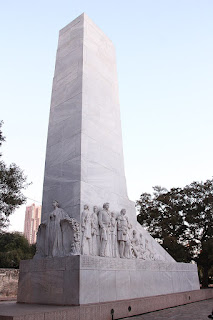Italian emigrant famous for Texas monument
The sculptor Pompeo Coppini, best known for the Alamo Cenotaph in San Antonio, Texas, was born on this day in 1870 in Moglia, a village in Lombardy a few kilometres south of the city of Mantua..jpg)
Pompeo Coppini spent much of his
career working in Texas
Coppini emigrated to the United States at the age of 26 and after initially working in New York moved to Texas, where the majority of his work can be found.
The Alamo Cenotaph, also known as The Spirit of Sacrifice, consists of a 60ft high sloping shaft of grey Georgia marble resting on a base of pink Texas granite. Carved into the sides of the monument, erected near the scene of the siege of the Alamo Mission during the Texas Revolution in 1836, are images of the Alamo defenders including William B Travis, Jim Bowie, David Crockett and James Bonham, while the names of those who died at the Alamo were etched along the base.
It was commissioned to commemorate the centenary of the siege and took two years to complete. It is now the centrepiece of a square known as the Alamo Plaza.
The son of a musician, Pompeo moved with his family from Moglia to Florence in 1880 at the age of 10. His craft skills began to earn him an income at an early age through work with ceramics and miniature models of famous monuments.
 |
| Coppini's most famous work is the Alamo Cenotaph in San Antonio |
Upon graduating, he opened a small studio and continued to make items he could sell, including busts of local celebrities and cemetery monuments.
Business was slow, however, and in 1896, Coppini followed the example set by others of his generation in deciding to move to the United States, specifically New York.
He arrived there, reportedly with nothing but a trunk full of clothes and $40 in cash, and found work sculpting figures for a wax museum before being commissioned to create a memorial to Francis Scott Key, best known for writing the lyrics for the American national anthem The Star-Spangled Banner.
A model hired to pose for Coppini’s memorial to Key, Elizabeth di Barbieri, ultimately became his wife.
His progress in New York was steady if not spectacular. Craving a base which would give him more chance to stand out, in 1901 he moved to Texas to work alongside the German-born sculptor Frank Teich. A year later he became an American citizen.
Apart from his most famous work, sculpted with the help of a $100,000 donation from the state of Texas, Coppini’s other creations in Texas include the Confederate Monument in Paris, Terry's Texas Rangers Monument and Hood's Texas Brigade Monument in Austin, the Littlefield Memorial Fountain, also in Austin, with which he worked with the French-born architect Paul Cret, and several statues at the Texas State Fair Hall of State in Dallas.
 |
| Coppini's Littlefield Memorial Fountain at the University of Texas in Austin |
Coppini died in San Antonio in 1957, his body laid to rest in the city’s Sunset Memorial Park in a tomb he sculpted himself.
Travel tip:
Moglia, the village where Coppini was born, is situated a little over 30km (19 miles) south of Mantua in Lombardy. With a population of more than 5,000 today, it has grown to about five times its size in the last 150 years. A feature is a marble monument by Coppini to the Martyrs of War, finished in 1951 and sited in front of the village’s primary school. Moglia was hit badly in the 2012 earthquake that hit the area, with the Town Hall, the parish church and several other buildings in the historic centre suffering severe damage, along with many private residences.
Travel tip:
The Palazzo Ducale in Mantua was the home for
four centuries of the Gonzaga family
Mantua is an atmospheric old city in Lombardy, to the southeast of Milan. In the Renaissance heart of the city is Piazza Mantegna, where the 15th century Basilica of Sant’Andrea houses the tomb of the artist, Andrea Mantegna. The church was originally built to accommodate the large number of pilgrims who came to Mantua to see a precious relic, an ampoule containing what were believed to be drops of Christ’s blood mixed with earth. This was claimed to have been collected at the site of his crucifixion by a Roman soldier. Mantua is famous for its Renaissance Palazzo Ducale, the seat of the Gonzaga family between 1328 and 1707, in which the Camera degli Sposi is decorated with frescoes by Mantegna, depicting the life of Eleonora’s ancestor, Ludovico Gonzaga and his family in the 15th century.
Also on this day:
1860: The birth of politician Vittorio Orlando
1946: The birth of actor and director Michele Placido
1979: The birth of footballer Andrea Pirlo
.jpg)
No comments:
Post a Comment